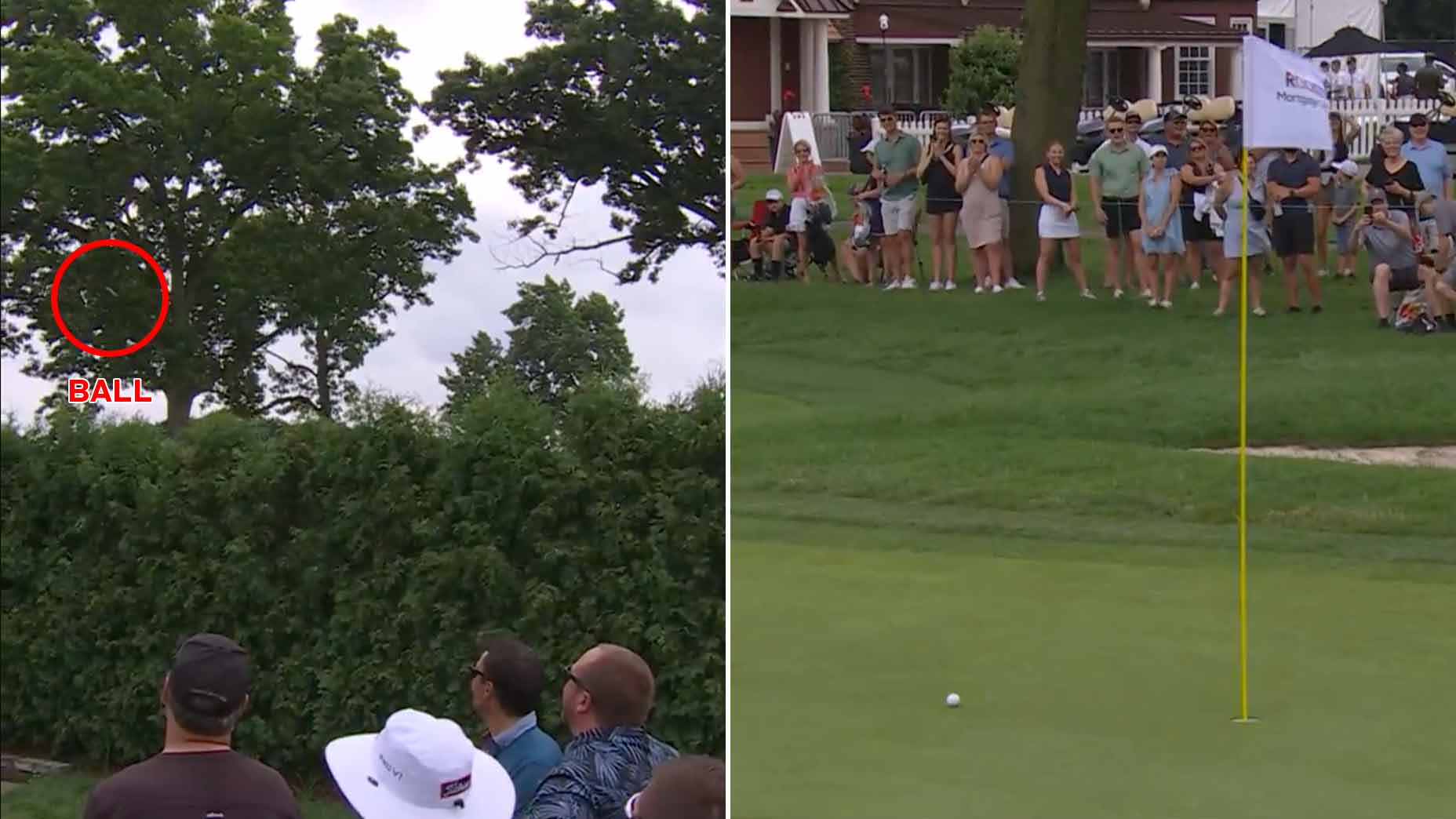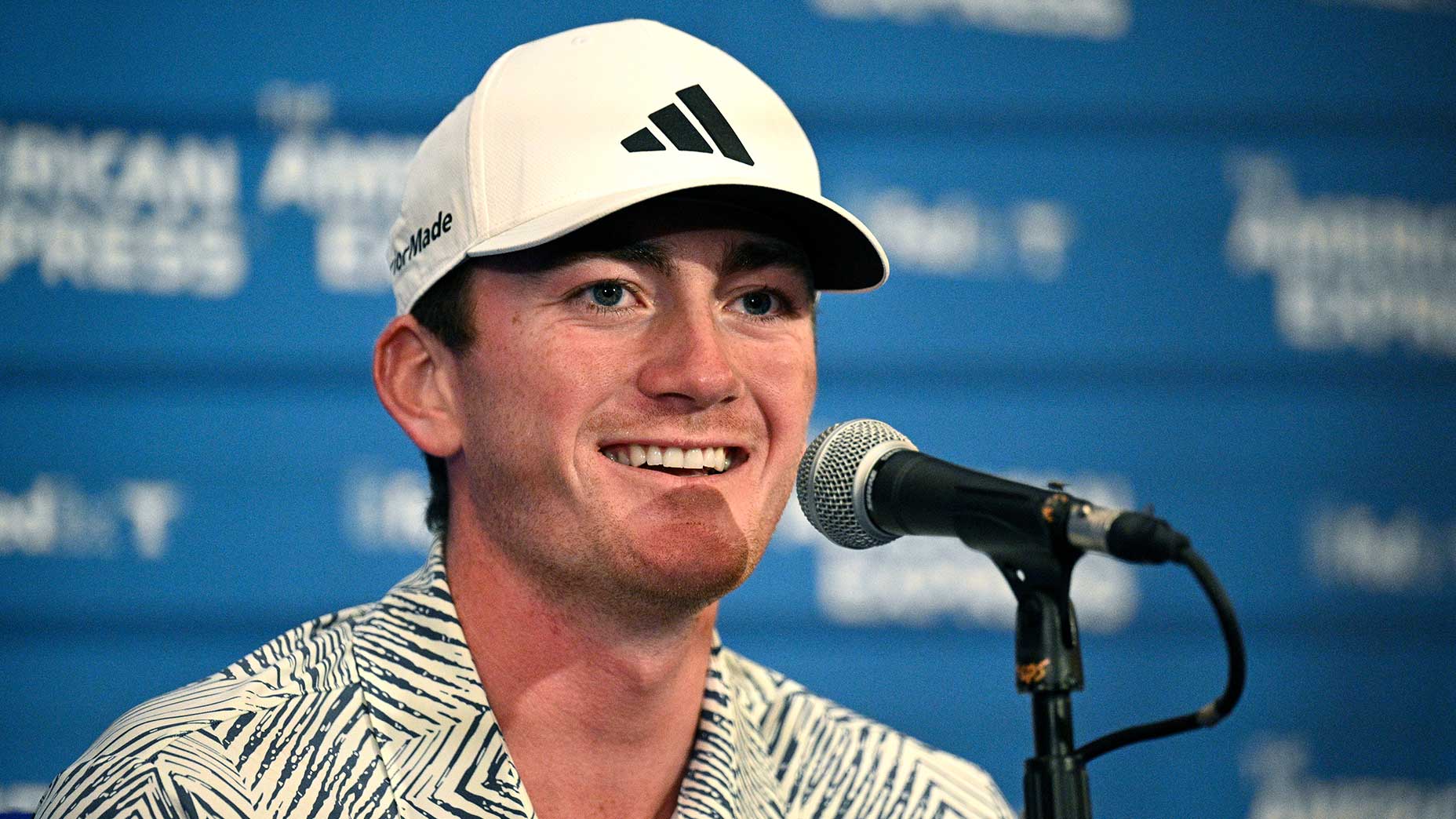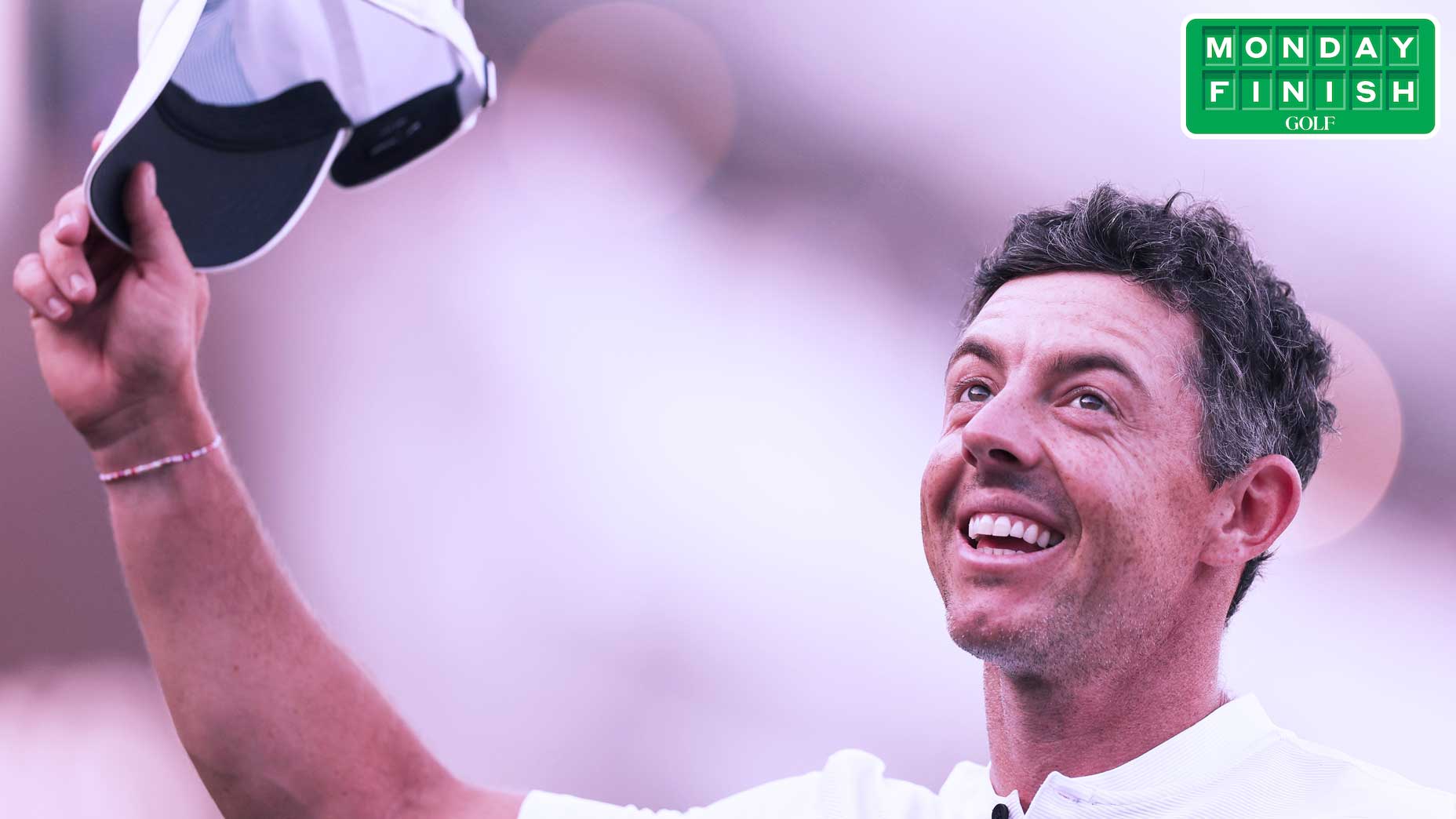In stunning win, Nick Dunlap showed his best asset might be between his ears

Nick Dunlap moments after winning the American Express on Sunday.
getty images
LA QUINTA, Calif. — The prodigies shout their arrivals. That is, their golf does the shouting for them. Bob Jones. Big Jack. Seve. Tiger. This kid, this bizarrely mature young man named Nick Dunlap. He turned 20 two days before Christmas.
Now Nick Dunlap, a sophomore at Alabama, is the second-youngest winner in the history of the PGA Tour, which was formally organized in 1968. (Jordan Spieth won on Tour as a 19-year-old in 2013.) Now Nick Dunlap is the first amateur winner of a PGA Tour event since Phil Mickelson, who, as a junior at Arizona State in 1991, won the Tucson Open, five months before his 21st birthday.
Dunlap won the American Express, the Tour’s only three-day pro-am, on Sunday here by one skinny shot when a hundred other, quote, can’t-miss college stars might have been happy to wave a white flag at some point in the chaos of Sunday on the PGA Tour, and contentedly sign for a top-five finish.
Not this Nick Dunlap. For three days, it was relatively easy, and the golf was almost, almost casual. (Dunlap, borderline fidgety, says he always starts rounds with his nervous system on high alert, no matter what kind of event he is playing in.) He played with two well-heeled amateurs and another pro on Thursday and Friday and Saturday. He had the honor on one tee box after another, on the basis of 64, 65 and a Saturday 60 at La Quinta Country Club, which has spectacular, flat greens where any tracking putt could tumble on in. He made everything in that round, with maybe 50 people following him and a light rain falling as he stuffed a final approach shot into the final green for a final birdie. He was the 54-hole leader by three shots, over Sam Burns.
But on Sunday, coming off the 12th green at the Stadium Course, a time-capsule of Pete Dye 1980s golf, Dunlap found himself trailing Burns by a shot as he muttered to himself what any player would at the very least be thinking in that situation: “F—.”
Live sport. What is there like it? Moments come and moments go and you’re not getting them back. Like the veteran Tour caddie Dave Markle says, here’s a stat you can’t measure: Strokes gained, attitude. One round showed Dunlap’s attitude: grind, grind, grind. He made a double bogey on the short par-4 7th hole, doing the only thing you cannot do with a long-iron tee shot: a shove-push-slice into a pond. But then he made a birdie on the next, a par-5. You have to make birdies on the par-5s in this event. All three courses are par 72s in name only.
Dunlap’s first Sunday in a PGA Tour event, in the day’s final group. Now there was a roving NBC Sports camera in his face as he came off various tee boxes. (NBC has longstanding ties to this tournament, going back to its days when Bob Hope, the amateur golfer and iconic comedian, was its host. The Hope-NBC relationship began, in radio, in 1935!) Now there were hundreds of spectators following him, sometimes calling out to him. Now there was a PGA Tour official, giving the day’s final threesome a slow-play warning.
Now he was playing for keeps, trying to capture the day, secure his future, bring pride to his peeps, his parents and coaches and girlfriend and teammates and friends, a dozen of whom had flown in for the occasion. That adds pressure. That adds pressure! But you can’t tell your people to stay home, not if you want to keep them as your people.
And, in addition to all that, during his Sunday golf Dunlap had to block out the thing that occupied his Saturday night, the many, many scenarios running through his head, all of which may be summarized by a single lyric known to many: Should I stay or should I go?
Maybe, he’ll want to play the Masters as an amateur. (There’s something special about that, staying in the Crow’s Nest, maybe making it to Butler Cabin early on Sunday night, and it can pay dividends overtime, too. Golfing personalities as varied as Ben Crenshaw, Tiger Woods and Andy Ogletree can tell you that.) Maybe Dunlap will want to try to help Alabama in the NCAA golf tournament this May. With NCAA-approved NIL money available to him, Alabama boosters could help Dunlap make his final stretch as an amateur very comfortable. As in all of life, it’s always useful to follow the money as you try to figure why people do the things they do. We’ll save NIL for another time, but to date it takes its bookkeeping practices out of a playbook last seen in the Wild, Wild West.
And let’s not forget that LIV Golf, and its PIF-backed billions, always hovers these days. Jon Rahm and Phil Mickelson, LIV golfers, are both represented by Steve Loy, a senior executive at Sportfive, an international agency which runs the American Express tournament, which, for its first three days, features 156 paying amateurs and 156 pros for the first three rounds. Well, this year 157 amateurs and 155 pros, because of Dunlap.
American Express gave Dunlap a sponsor’s exemption to the tournament about two weeks ago. There was once a time — and Tiger Woods in 1996 is a prime example of it — that elite amateur golfers thinking about a path to the PGA Tour would not want such exemptions. Players were and are allowed seven exemptions in a year and the thinking then was take them after you turn pro, so that you might earn your Tour card in those seven starts. But all of golf has been turned on its head. That is, all of golf off the course. The beauty of Sunday at the American Express is that it was just golf. By having the letter a next to his name, it was almost as if Nick Dunlap was standing up for the game as millions of fans know it, the gallant four-day struggle to post the lowest score you can, trying to present yourself to the world as a normal human being all the while. That’s what Nick Dunlap did.
But not for a minute on Sunday did he Dunlap look scared, overmatched, not ready. This includes the long, long minute he spent reading and considering his five-foot-something left-to-right putt to win. His caddie, Hunter Hamrick, a former Alabama player and assistant coach, gave him an inside left read and inside left it was. Dunlap putts cross-handed, his stroke is almost wristy and it has the rhythm of a Steph Curry free throw.
He’s the most old-headed, golf-wise 20-year-old this reporter has ever seen. Tiger’s thing was different, more I-own-you. Spieth’s thing was different, more short-game artistry. Nick Dunlap’s thing is broad excellence. In the Sam Burns tradition. (They have similar physiques and swings, too, with relatively short and slow backswings, ferocious and fast downswings, long and full finishing positions.) Burns is 27 and he’s won five times on Tour. Maybe Dunlap can be that good. Maybe!
Is Dunlap as good as Sergio was at 20? Or Jon Rahm? Or Phil at that age? Or Shark? (We’re not obligated to give LIV equal time, but, you know.) Hard to say. Hard to say after four rounds on short courses with no trees, with magic-carpet greens and little wind. With his closing 70, Dunlap finished 29 under par, to win by a shot over Christiaan Bezuidenhout of South Africa. It is amazing how many elite golfers are Afrikaners.
It’s also amazing how many elite golfers in recent times are only children. Michelle Wie is an only child. So is Justin Thomas, Rory McIlroy and Tiger Woods. (Yes, Earl Woods had three children with his first wife, but only one with Tiger’s mother, Tida.) Nick Dunlap is an only child, too. An only child who was homeschooled.
He won the U.S. Amateur last year. He won the boys’ USGA junior title in 2021. This week he’s playing at Torrey Pines on a sponsor’s exemption. Will he be a pro by the time he tees it up on Thursday? He could be.
Either way, he’ll be playing in the Masters, whether he’s a pro by then or not. Ditto for the U.S. Open. He’s going to make money in this game. What he showed on Sunday, in his play and in his comments in victory, is that he is taking nothing for granted.
What Dunlap showed on Sunday, in his play and in his comments in victory, is that he is taking nothing for granted.
In victory, he was asked about his golf dreams as a kid. He said he had dreams, “literally, about a chance to win a PGA Tour event. As a kid, you kind of whack it around all over the putting green and every putt is for a chance to win, whether it’s a PGA Tour event, the Masters, the U.S. Open. And to have that putt [to win]: I took a little bit longer than I normally might, just to take in the moment. [I take] nothing for granted. I may not ever have that chance again, and I just wanted to embrace it.“
Do you know another 20-year-old with enough life experience to think those things and say those things to a roomful of strangers? Well, there were a lot of people he knew, too.
Dunlap is from Huntsville, Ala., and he’s a sophomore at the University of Alabama. Justin Thomas, native son of Kentucky, played two years at Alabama and was one of his playing partners on Sunday. The third was Sam Burns, born and raised in Louisiana.
The Tour was once so Southern, but those days are gone. The Tour was once about grinding out a win on Sunday with guys breathing down your neck. A player was promised nothing. This AmEx was that. Burns, stunningly, putting his tee shots into lakes on the par-3 17th and the par-4 18th on Sunday was all the proof you needed that professional golf promises you nothing. (Except when it does.)
This week in the California desert was throwback Thursday, if that’s still a thing. It was Mickelson winning the Tour stop in Tucson in 1991, when he was a junior at ASU. That was a coming-of-age moment. Woods, when he contended on Tour as soon he left Stanford after two years and went hello world in the late summer of ’96: the same. Nicklaus, when he got paired with Arnold Palmer at the 1962 Phoenix Open. Arnold won, Jack seconded by 12, but he had made an entrance in the pro game. You need a stage to have a coming out party. Nick Dunlap had one on Sunday on a cart-golf resort course here.
His girlfriend, Isabella Ellis, a fellow Alabama undergrad, flew in for the final round. So did the Alabama head coach, Jay Seawell. (Seawell, on Sunday night: “Some of our players stay for one year. Some, like Justin, stay two. Some stay three and four. We have no expectations.”) Dunlap’s very unofficial swing coach, Jeff Curl, the son of the former Tour player Rod Curl. Nick Dunlap had an entourage out there. That adds pressure, too.
A decade ago, Jeff Curl, a former touring pro, saw Nick on an Alabama driving range. “I didn’t know a nine-year-old could swing like that,” Curl said on Sunday. “His eye-hand coordination is just incredible. He could have played any sport. He just happened to fall into golf.”
“Hank’s looking at you,” Curl said to Dunlap, moments after he holed that final putt. They both looked up, in the general direction of a rising moon. Curl was referring to the late Hank Johnson, a legendary Alabama golf instructor who died in 2021 at age 80. If Dunlap had a golf teacher, it was Hank Johnson. But Dunlap grew up in an era when you could watch any swing you wanted to on YouTube, and he did. He was asked about his go-to players.
“I think you’d be dumb not to say Tiger, right?” Dunlap said. “I think I have maybe a little bit of a Dustin Johnson move through the ball. But I think everybody wanted to swing like Tiger. I mean, he’s won however many times, however many majors. I always wanted to swing it like Tiger. I just couldn’t.”
So he swings it like Nick Dunlap. The am who beat the pros. That’s not as shocking as it was when Mickelson did it, because the ams, the best of them, are pros, and when they get on tour, no matter what tour it is, they’re ready to go. What made this win so special was how unexpected it was. What made this win so special was that it was all about the golf, the grind, the pressure, the water, the hole, the scores. He won by one and that was enough.
The kid is angular and lean. There’s nothing movie-star about him. By Sunday night, he was absolutely, completely spent. His mouth was dry. His eyes were watery. His face was red. His shirt was half out. It was beautiful.
Michael Bamberger welcomes your comments at Michael.Bamberger@Golf.com















